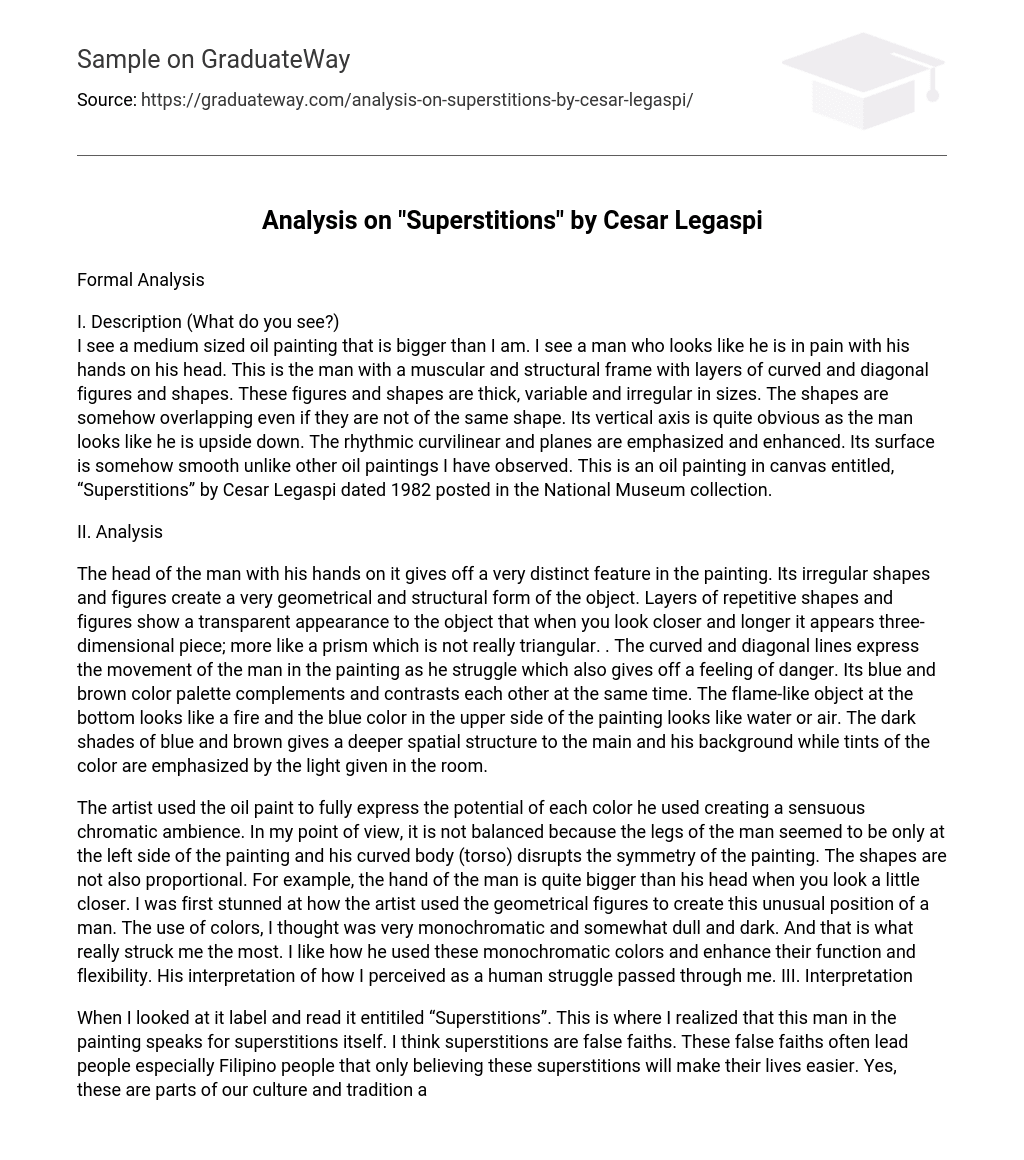Formal Analysis
I. Description (What do you see?)
I see a medium sized oil painting that is bigger than I am. I see a man who looks like he is in pain with his hands on his head. This is the man with a muscular and structural frame with layers of curved and diagonal figures and shapes. These figures and shapes are thick, variable and irregular in sizes. The shapes are somehow overlapping even if they are not of the same shape. Its vertical axis is quite obvious as the man looks like he is upside down. The rhythmic curvilinear and planes are emphasized and enhanced. Its surface is somehow smooth unlike other oil paintings I have observed. This is an oil painting in canvas entitled, “Superstitions” by Cesar Legaspi dated 1982 posted in the National Museum collection.
II. Analysis
The head of the man with his hands on it gives off a very distinct feature in the painting. Its irregular shapes and figures create a very geometrical and structural form of the object. Layers of repetitive shapes and figures show a transparent appearance to the object that when you look closer and longer it appears three-dimensional piece; more like a prism which is not really triangular. . The curved and diagonal lines express the movement of the man in the painting as he struggle which also gives off a feeling of danger. Its blue and brown color palette complements and contrasts each other at the same time. The flame-like object at the bottom looks like a fire and the blue color in the upper side of the painting looks like water or air. The dark shades of blue and brown gives a deeper spatial structure to the main and his background while tints of the color are emphasized by the light given in the room.
The artist used the oil paint to fully express the potential of each color he used creating a sensuous chromatic ambience. In my point of view, it is not balanced because the legs of the man seemed to be only at the left side of the painting and his curved body (torso) disrupts the symmetry of the painting. The shapes are not also proportional. For example, the hand of the man is quite bigger than his head when you look a little closer. I was first stunned at how the artist used the geometrical figures to create this unusual position of a man. The use of colors, I thought was very monochromatic and somewhat dull and dark. And that is what really struck me the most. I like how he used these monochromatic colors and enhance their function and flexibility. His interpretation of how I perceived as a human struggle passed through me. III. Interpretation
When I looked at it label and read it entitiled “Superstitions”. This is where I realized that this man in the painting speaks for superstitions itself. I think superstitions are false faiths. These false faiths often lead people especially Filipino people that only believing these superstitions will make their lives easier. Yes, these are parts of our culture and tradition and we should also preserve it by living by it but we must also realize that these are detours and even roadblocks to our goals. These often lead us to danger. When we look closely into the painting, the man is in an upside down position with his hands on his head looking like he is in pain and screaming. As mentioned earlier, the blue background in the upper side of the painting looks like water or air while the bottom part looks like fire. These are evidences that the man has “fallen” into his own beliefs and from where he stands as a person.
His legs are together curled in the upper left part of the painting can mean that he has gone to other side of what is right and practical. Seeing that the man is bare and naked, his innocence is portrayed showing that he believes what other people tells him and easily follows what the society tells him. This should also be the reason why his hand is holding his head while his upper torso immerses in the fire. I also think that the artist used these two colors: blue and brown to symbolize our country. Brown for the land mass or the islands and blue for water surrounding it. This painting expresses that our country should stand for what we believe in and fight for it. We should not just always accept what the society tells us and reason out that it is what we grew up with. This way of thinking is wrong and will lead us to danger and suffering. IV. Evaluation
I think the criteria for judging an artwork is design, style of the artist, meaning, and originality. These criteria are simple but concise criteria that any other person would use when evaluating an artwork not only a painting. The artist, Carlos Legaspi is a pioneer of Neo-realism in the Philippines. His style not only in this painting but in all of his works showed is contrary to the angularity of the original style. He is a cubist which means he uses geometrical figures. This use of geometrical fragmentation weaving social comment and contrasting the mythical and modern into his overlapping, interacting forms with power and intensity makes it original and unique. This artwork is not just any work but also inspires and advocates what the society has been missing out. His artistic language conveys a wide range of values from sensitivity to strength, power to grace and lyricism to dynamism. In my standpoint, I will definitely call it a good artwork as it not only expresses the ideas and thoughts of the artist but interacts and engages with the society. This is not only about the feelings of the artist but about the state of living of human especially the Filipinos.





